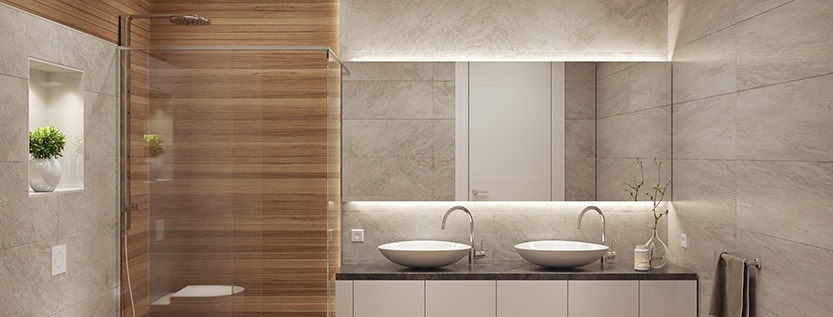
Sanitary Engineering
Planning of sanitary facilities
Every modern building is much more than just a shell of concrete, steel and glass. Rather, it is a complex structure in which different systems interact to make a building fulfil its function.
Parts of these systems are called supply engineering, sometimes also technical building equipment (abbreviation TGA). These systems perform different tasks, for example heat supply, ventilation, lighting, elevator and conveyor technology and others.
Sanitary engineering is one of the indispensable components of supply engineering.
What are the tasks of sanitary engineering?
Within the technical building equipment, sanitary engineering is responsible for the provision of gas, drinking water and process water. Sanitary engineering also includes the treatment, drainage and disposal of waste water. The recycling of rainwater as service water or the natural return of collected rainwater to the environment also falls within this area.
In contrast to heat supply or lighting, sanitary engineering is a material supply for the building.
An essential planning aspect in the planning of drinking water installations is to ensure drinking water hygiene to maintain the health of all people who come into contact with the medium drinking water in any form in the buildings. Without sanitary engineering, residential buildings would not be usable as living space for humans and animals and functional buildings such as clinics, schools or laboratories would not be able to fulfil their intended purpose.
What are sanitary objects and fittings?
Water or gas is supplied through pipes. Depending on the requirements of the technology and the building structure, these run visibly on walls and ceilings or are concealed in shafts and suspended ceilings. Sanitary objects and fittings, on the other hand, are always visible system elements and are in direct contact with people every day in their function. They thus represent
the interface between sanitary engineering as a supply system and the people as users of the system. As a result, sanitary objects and fittings are used daily by everyone around the world, mostly without being consciously noticed by them. Sanitary objects and fittings include:
- Toilet bowl
- Washbasins and gutters
- Bathtubs
- Shower trays
- Urinals
- Bidets
- Kitchen sinks
- One handle fittings
- Single lever mixer taps
- Thermostatic fittings
- Electronic fittings
- Self-closing fittings
- Garden blasting valves
- Drinking fountain
- Device connection fittings
Commercially available sanitary objects are usually made of porcelain or ceramics, but enamelled sheet steel or acrylic is also frequently used. In addition, object materials made of natural and artificial stone are used for high-quality finishing. In the fittings segment, metallic basic bodies made of brass, gunmetal or stainless steel are common, which are offered with polished, brushed lacquered, chrome-plated or coloured surfaces, depending on the individual freedom of design.
Sanitary engineering as part of building services
Like the other areas of supply engineering, sanitary engineering is taken into account from the very beginning in the planning process of a building. For this purpose, complex and universally applicable planning software such as Plancal or Dendrit are available to the planner.
Based on the corresponding sets of rules and regulations, the programs ensure a rule-compliant and economically optimal design of the sanitary systems when used properly.
By means of trade-spanning three-dimensional working levels, the programs today also offer coordinating possibilities for architecture and technical equipment. Through consistent use of the three-dimensional planning space and a constantly updated planning background, collision points in the normal planning process can be identified and resolved at an early stage.
Sanitary engineering requires continuous support
Particularly when it comes to planning, installation, maintenance and the ongoing operation of drinking water systems, the legal regulations and technical codes of practice have become more and more stringent in recent decades with regard to ensuring and providing a hygienically safe foodstuff, drinking water. These regulations apply to the entire drinking water cycle, starting with water pumping via well systems, water treatment in the waterworks, water distribution in public areas, right up to the drinking water installation in your own home.
The current regulations and ordinances have legal character and must always be implemented in a binding manner; there is no protection of the status quo from a hygiene point of view for existing installations.
Summary
The sanitary engineering is part of the supply engineering and belongs to the material supply of the building. Its task is to provide gas and drinking water in sufficient quantity and quality. The disposal of waste water is also part of this, as is the treatment of waste water from certain types of buildings, such as restaurants or hospitals, laboratories, e.g. in separation plants for oils and fats or decay tanks, neutralisation plants and similar.
Due to the increasing scarcity of water in the world and the progressive sealing of our soils as a result of constant construction activities, the use of rainwater or its return to the natural water cycle is increasingly coming into focus. The development of concepts for rainwater utilisation and rainwater infiltration systems is one of the core tasks of sanitary engineering planning today and will become even more important in the future.



